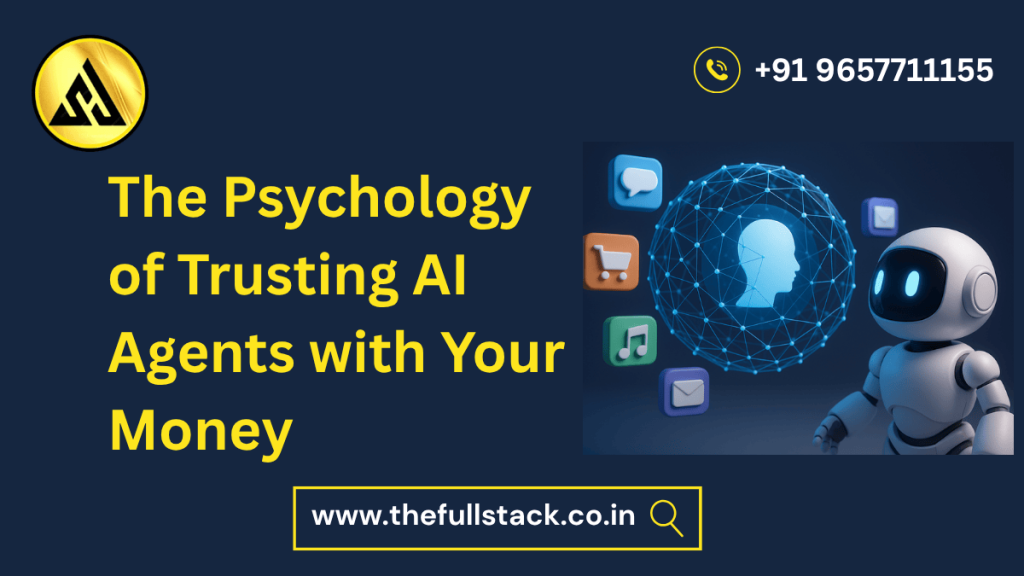Would you hand over your hard-earned money to a machine? For many people, the idea sounds intimidating. Yet in today’s fast-moving financial world, AI agents—intelligent systems designed to analyze data and make decisions—are becoming powerful allies in trading, investing, and personal finance management.
But before you can trust AI with your money, you need to understand the psychology behind it. Why do we hesitate to let go of control? How do we build confidence in AI systems? And where do we draw the line between human judgment and machine intelligence?
In this blog, we’ll explore the psychology of trusting AI in finance, the key challenges, market trends, and how you can start building confidence in using AI agents for smarter financial decisions.
Why Trust Matters in AI-Driven Finance
Money is emotional. For most people, it’s not just currency—it represents security, freedom, and even dreams for the future. That’s why handing over financial decisions to AI requires a psychological leap of faith.
Here’s what drives the trust factor:
- Transparency – People trust what they understand. If an AI agent explains its reasoning, confidence grows.
- Track Record – Proven accuracy and consistent results help reduce doubts.
- Control – Knowing you can override or guide AI decisions makes people more comfortable.
- Social Proof – Seeing banks, companies, and other investors use AI builds credibility.
The challenge is that AI often operates as a “black box”—fast, accurate, but not always explainable. That uncertainty can trigger fear, hesitation, or skepticism.
The Psychology Behind the Fear
When beginners think about AI managing money, two common psychological biases show up:
- Loss Aversion: Humans fear losing money more than they value gaining it. If AI makes a mistake, it feels worse than when we make a mistake ourselves.
- Control Illusion: Many investors believe they make better decisions when in control, even if the data shows otherwise.
Overcoming these biases requires both knowledge and experience. By understanding how AI works and testing it in small steps, you start building trust gradually.
How AI Agents Work in Finance
Before we talk about trust, let’s simplify what AI agents actually do with your money:
- Robo-Advisors: AI systems that recommend portfolios based on your goals, risk tolerance, and timeline.
- Trading Bots: Algorithms that execute trades in real time based on market signals.
- Fraud Detection Agents: AI that safeguards your accounts by spotting unusual transactions.
- Personal Finance Assistants: Apps like Mint or Cleo that analyze spending and suggest smarter budgeting.
In each case, AI isn’t acting randomly—it follows data-driven rules and patterns designed to minimize risk and maximize opportunity.
Market Trends: Why Trust in AI is Growing
Trust in AI agents is rising fast, thanks to several trends:
- Mainstream Adoption: From Robinhood to Zerodha, popular apps now include AI-driven features.
- Explainable AI (XAI): Platforms increasingly show why an AI made a recommendation.
- Regulation: Governments are enforcing accountability, making AI safer to use.
- Generational Shifts: Younger investors, used to digital assistants like Siri and Alexa, are more open to trusting AI with money.
According to industry reports, AI-powered wealth management is expected to reach hundreds of billions of dollars in assets under management (AUM) within the next few years.
Building Psychological Trust: A Step-by-Step Approach
Here are some practical tips to help you build confidence in AI-driven finance:
- Start Small
Use AI for budgeting apps or low-risk portfolio recommendations before handing over bigger investments. - Learn the Basics
Understand common financial indicators—like risk scores, diversification, and returns—so AI recommendations make sense. - Test AI Predictions
Compare AI’s suggestions with your own research. Over time, you’ll see patterns that build trust. - Use Hybrid Models
Opt for human-in-the-loop systems where you approve AI decisions. This way, you stay in control while benefiting from machine speed. - Check Transparency
Choose platforms that explain their AI logic, not just give buy/sell signals. - Focus on Long-Term Gains
Remember: AI agents are designed to optimize results over time, not win every single trade.
Relatable Example
Imagine you’re planning for retirement. A robo-advisor asks about your age, income, and goals. It then suggests:
- 60% in low-risk bonds
- 30% in equities
- 10% in alternative assets
Without AI, you might feel lost deciding where to start. With AI, the recommendations come backed by historical data and market analysis. You still make the final call—but now with clarity and confidence.
The Human-AI Partnership
The future of finance isn’t about replacing human decision-making. It’s about enhancing it.
- AI offers speed, consistency, and data-driven insights.
- Humans bring emotional intelligence, ethics, and long-term vision.
Together, this partnership creates smarter, safer financial outcomes.
Challenges That Still Remain
While AI is powerful, it’s not perfect. Challenges include:
- Bias in Data – If the AI is trained on biased data, results may be skewed.
- Over-Reliance – Some users may blindly follow AI without understanding risks.
- Cybersecurity Risks – Trust also depends on protecting your money from digital threats.
The solution? Balance AI efficiency with human oversight and continuous learning.
Conclusion: Trust the Process, Trust Yourself
Trusting AI with your money isn’t about surrendering control—it’s about gaining a powerful tool to support your financial journey. The psychology of trust develops through understanding, small steps, and real results.
Whether you’re a beginner investor or a company employee exploring AI for finance, remember: the goal isn’t to eliminate risk, but to make smarter, informed choices.
👉 Ready to take the first step?
Explore our advanced learning resources and courses on AI in finance to build confidence, sharpen your knowledge, and achieve long-term financial success.
It might ne helpful:
The Power of Java: Advantages, Features, and Applications

